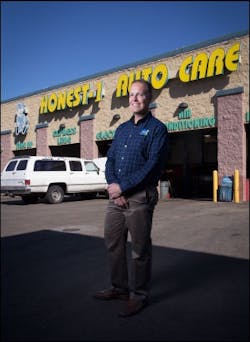When Rich Margo walked into the Honest-1 Auto Care shop, he immediately knew something was wrong.
“Having been in the industry and having received a wealth of training from different companies, I could identify operational and procedural challenges that [the owner] was struggling with,” Margo says. “At this shop, the tail was wagging the dog.”
At this point in 2004, Margo had just become the owner of another Honest-1 Auto Care franchise in Las Vegas. To get a feel for the business, he stopped into a sister shop across town.
But within 30 minutes of speaking with the then-owner of that Honest-1 shop, Margo identified potential business killers everywhere: The shop was overstaffed; there were unmotivated employees; the owner had poor vendor relations; there was a lackluster inspection process; customer service was poor.
SHOP STATS
Honest-1 Auto Care
Las Vegas
Owner: Rich margo
Size: 3,200 square feet
Staff: 5 (3 technicians, 1 manager, 1 owner)
Average Monthly Car Count: 240
Annual Revenue: $720,000
Not only did Margo identify those problems, but he also knew how to implement new procedures and rectify the flailing business that, just a few months after his initial visit, finished October $40,000 in the red.
So, in October 2005, as he was waiting for his own Honest-1 shop to open, Margo got the phone call. An experienced business owner himself, having managed both Pep Boys and Big O Tires shops in the Las Vegas area, Margo was asked to step in and save the struggling shop—and do so in just 30 days.
The Backstory
Margo had spent his career managing at various franchises, and in 2004, he was looking for an ownership opportunity in a new business that had yet to establish itself. He found it with Honest-1 Auto Care, which now has locations in about 50 cities across the U.S.
Margo and the franchise came to an agreement, and he was set to open his first Honest-1 Auto Care shop in Las Vegas across town from that sister location.
Then came the shop visit, and, sure enough, six months into his shop’s existence, Margo got that phone call.
“The [Honest-1] franchise owner asked me if I could help him because the shop didn't have good operations, training procedures, policies or personnel in place,” Margo says. “The local franchiser and area reps wanted me to help this guy. He's been in there four months and he's losing money hand over fist.”
“Look, I'll come and be your manager,” Margo said to the then-owner. “You take a couple weeks to collect yourself and get yourself together, I'll have it straightened out for you when you get back. I'll take a weekly salary for my time here, and then, once we're profitable, we'll split the profits 50/50."
The Problem
The main expense that was killing the Honest-1 shop was, as Margo referred to it, a “Three Stooges” problem.
“One guy is standing around with a cigarette in his hand, the other guy is under the hood, and another guy is standing around screaming, ‘Ratchet!’” Margo says. “And every one of these guys is on salary. They're breaking this owner. The catalog would call for four hours, and the tech would come to him and say, ‘That's going to take me seven or eight hours to do.’”
During his initial visit to the shop, Margo also noted how inefficient the then-owner’s estimating process was.
“He was calling and pricing parts with three or four different suppliers, trying to get the customer the best price,” Margo says, “instead of having a relationship established with a primary supplier. He would spend an hour just trying to put together a price for one estimate and running himself ragged.”
Not only was the then-owner wasting time and money on finding a supplier, he was stressing himself out and making the customers wait, leading to poor customer relations that killed future business opportunities—putting all the money the then-owner had invested in advertising to waste.
“He brought traffic in, but there was no plan inside the shop operationally to handle the customers coming in,” Margo says. “First-time customers weren’t coming back because the speed of service was not there.”
Margo also noted that customers weren’t invested in the shop because its inspection process was so poor. The shop wasn’t looking to educate customers on maintaining vehicles to industry standards, so the shop never gave the customer any reason to come back for additional work in the future.
“Whatever the car came in for, that's what got checked and inspected for and that's how it left, either getting fixed or estimated for,” Margo says. “There were not any additional maintenance item discussions, there were no maintenance plans.”
After Margo had identified all those problems, he scheduled out how he would turn the shop around in just one month.
The Solution
Right away, Margo knew he’d have to slash the staff in half, from six technicians to three.
“The most controllable expense is payroll,” Margo says. “So, when I first started looking at the numbers, that's the first thing I saw: It was too heavy on payroll. And it didn’t take much to figure out because of the design of the shop, like when you come into the lobby, there’s a nice four-by-four window that looks right into the shop from the lobby. Even the customers could see nobody was really working. They were probably 45 to 50 percent productive based off their logged time.”
How did Margo choose which employees to cut? Well, actually, he didn’t have to decide at all.
“I pulled all six of them into the office one by one, and said, ‘Good news! You're getting a raise. I’m taking you off of salary and putting you on flat-rate,’” Margo explained to them. “I took them off their base and said, ‘I'll pay you $25 an hour, but you're going to earn every hour of it.’
Margo also bandaged the then-owner’s poor vendor relations by establishing a primary relationship with one supplier. By reaching out to a single supplier, Margo cut down his estimating time substantially and was able to get more done around the shop.
“You really need a vendor you can go to every time and say, ‘Here's my standard. You're going to take care of me and I'm going to call you every time I need something,’” Margo says. “This is who I will call, who will treat me right, who will get me my parts fast.
“And then you have two or three back-up guys for when your first guy doesn’t have what you're looking for. You don't spend an hour building an estimate—you spend five minutes.”
Manning the front desk himself, Margo also completely revamped the shop’s behind-the-counter duties, educating and interacting with each customer in a stress-free environment. With a new staff and vendor system in order and more time on his hands, Margo was easily able to invigorate the inspection process by spending more time examining vehicles and advising additional maintenance to customers for future visits.
“I was able to utilize what the franchise owner had and piece together what I had learned in the past and create a nice inspection sheet and implement that right away,” Margo says. “And we immediately started seeing additional revenue from preventative maintenance items being sold.”
Once we've supposedly hired the right person, then you want to take them through full training, and not just throw them to the wolves. They need to have goals and feedback throughout that training, follow up on those goals once they start at their shop.
Then I'm going to have weekly meetings with them to review: Here's our KPIs, here's our goals. Did you meet them or did you not? If you did not meet them, then let me coach you. Let's listen to your phone calls: Three good phone calls and three coachable phone calls. We're going to review the KPIs, your production, your profits. I’m going to sit in on meetings and see how you work with your team. Then we find what steps to take in order to make change.
Once we get through that and they have been trained, at three months, that's when we make the final call. It is the best they will ever do. It has been proven time and time and time again. At three months, they will never get any better. You can keep saying, 'I feel like they can do it.' You can say it all day long, and 3 to 5 percent of the time that's the case. But 95 percent of the time it is not.
You have to be willing to make a change when it's staring you in the face. That's the biggest thing: make the change and be willing to pay for the mistake. If they stick around and you’re not coaching them and not giving them goals or accountability, then how will they be motivated to improve the numbers? It should be performance based.
The Aftermath
For the first time since it opened, the once downtrodden shop was turning a profit, going from $40,000 in the hole in October to netting $5,000 in profit in November—and it’s only built on its profits since.
After fixing that shop in just 30 days, Margo’s plan was to head back to his own Honest-1 shop, which was almost ready to open.
However, the then-owner’s plans had changed.
“He was supposed to come back and I was supposed to train him full-time on the front desk and show him the procedures that I had in place and give him whatever amount of training he needed until my other shop opened up,” Margo says. “Three weeks into my mission, the guy comes in in shorts and flip flops, picking up some mail, not a care in the world. I knew something was up.”
After conversations with the franchise owners, the then-owner ultimately decided the auto care life wasn’t for him, which “isn’t uncommon in this business,” says Margo.
“The plan was he would sell it to me for what he had into it,” Margo says. “I dipped into the operating capital I had set aside for my other shop and purchased this shop from him on Jan. 1, 2006. I've been running it ever since, and I set up a new manager at the other location.”
The Takeaway
Ultimately, Margo came away from the 30-day turnaround realizing how much his experience came in handy for such a dire situation.
“It’s weird. Subconsciously, I had been gaining all this knowledge, and I didn’t realize how easy it would be to implement everything I did until it came time to do it,” Margo says. “Being organized and putting together simple procedures seems secondhand, but it’s such a lifesaver for your business.”

